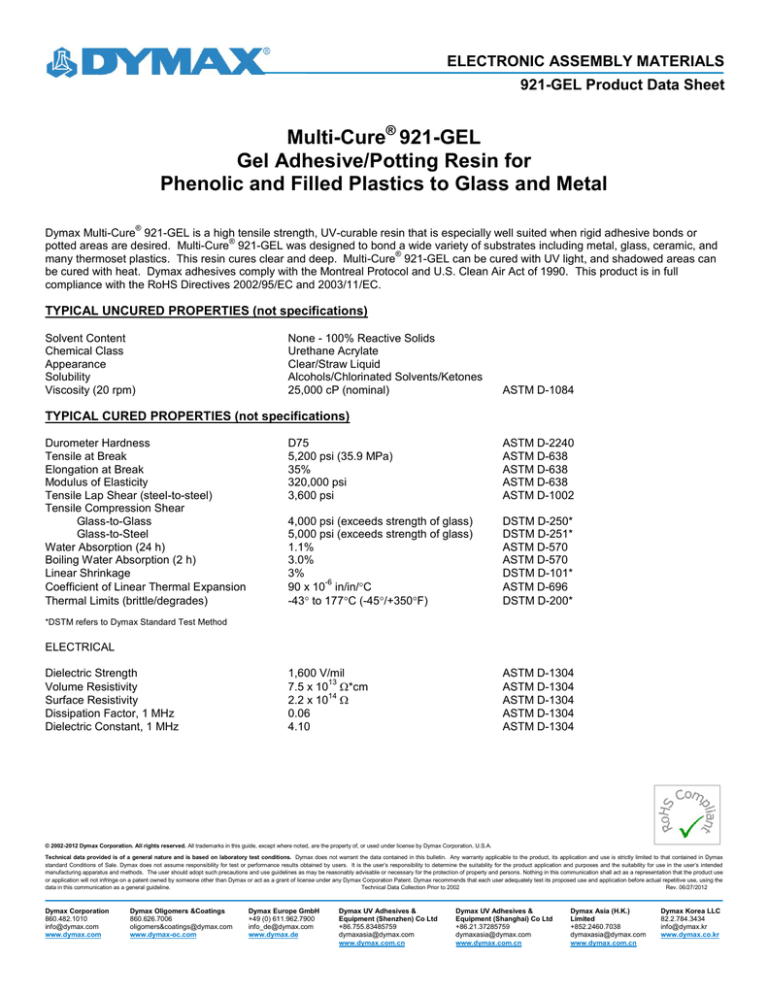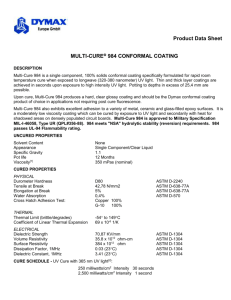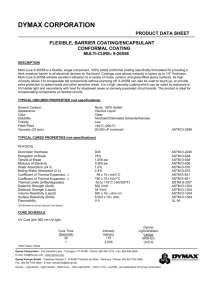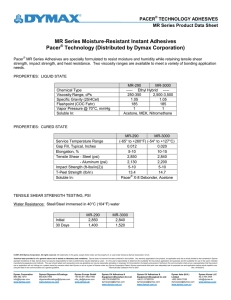
ELECTRONIC ASSEMBLY MATERIALS
921-GEL Product Data Sheet
Multi-Cure® 921-GEL
Gel Adhesive/Potting Resin for
Phenolic and Filled Plastics to Glass and Metal
®
Dymax Multi-Cure 921-GEL is a high tensile strength, UV-curable resin that is especially well suited when rigid adhesive bonds or
®
potted areas are desired. Multi-Cure 921-GEL was designed to bond a wide variety of substrates including metal, glass, ceramic, and
®
many thermoset plastics. This resin cures clear and deep. Multi-Cure 921-GEL can be cured with UV light, and shadowed areas can
be cured with heat. Dymax adhesives comply with the Montreal Protocol and U.S. Clean Air Act of 1990. This product is in full
compliance with the RoHS Directives 2002/95/EC and 2003/11/EC.
TYPICAL UNCURED PROPERTIES (not specifications)
Solvent Content
Chemical Class
Appearance
Solubility
Viscosity (20 rpm)
None - 100% Reactive Solids
Urethane Acrylate
Clear/Straw Liquid
Alcohols/Chlorinated Solvents/Ketones
25,000 cP (nominal)
ASTM D-1084
TYPICAL CURED PROPERTIES (not specifications)
Durometer Hardness
Tensile at Break
Elongation at Break
Modulus of Elasticity
Tensile Lap Shear (steel-to-steel)
Tensile Compression Shear
Glass-to-Glass
Glass-to-Steel
Water Absorption (24 h)
Boiling Water Absorption (2 h)
Linear Shrinkage
Coefficient of Linear Thermal Expansion
Thermal Limits (brittle/degrades)
D75
5,200 psi (35.9 MPa)
35%
320,000 psi
3,600 psi
ASTM D-2240
ASTM D-638
ASTM D-638
ASTM D-638
ASTM D-1002
4,000 psi (exceeds strength of glass)
5,000 psi (exceeds strength of glass)
1.1%
3.0%
3%
-6
90 x 10 in/in/C
-43 to 177C (-45/+350F)
DSTM D-250*
DSTM D-251*
ASTM D-570
ASTM D-570
DSTM D-101*
ASTM D-696
DSTM D-200*
1,600 V/mil
13
7.5 x 10 *cm
14
2.2 x 10
0.06
4.10
ASTM D-1304
ASTM D-1304
ASTM D-1304
ASTM D-1304
ASTM D-1304
*DSTM refers to Dymax Standard Test Method
ELECTRICAL
Dielectric Strength
Volume Resistivity
Surface Resistivity
Dissipation Factor, 1 MHz
Dielectric Constant, 1 MHz
© 2002-2012 Dymax Corporation. All rights reserved. All trademarks in this guide, except where noted, are the property of, or used under license by Dymax Corporation, U.S.A.
Technical data provided is of a general nature and is based on laboratory test conditions. Dymax does not warrant the data contained in this bulletin. Any warranty applicable to the product, its application and use is strictly limited to that contained in Dymax
standard Conditions of Sale. Dymax does not assume responsibility for test or performance results obtained by users. It is the user’s responsibility to determine the suitability for the product application and purposes and the suitability for use in the user’s intended
manufacturing apparatus and methods. The user should adopt such precautions and use guidelines as may be reasonably advisable or necessary for the protection of property and persons. Nothing in this communication shall act as a representation that the product use
or application will not infringe on a patent owned by someone other than Dymax or act as a grant of license under any Dymax Corporation Patent. Dymax recommends that each user adequately test its proposed use and application before actual repetitive use, using the
data in this communication as a general guideline.
Technical Data Collection Prior to 2002
Rev. 06/27/2012
Dymax Corporation
860.482.1010
info@dymax.com
www.dymax.com
Dymax Oligomers &Coatings
860.626.7006
oligomers&coatings@dymax.com
www.dymax-oc.com
Dymax Europe GmbH
+49 (0) 611.962.7900
info_de@dymax.com
www.dymax.de
Dymax UV Adhesives &
Equipment (Shenzhen) Co Ltd
+86.755.83485759
dymaxasia@dymax.com
www.dymax.com.cn
Dymax UV Adhesives &
Equipment (Shanghai) Co Ltd
+86.21.37285759
dymaxasia@dymax.com
www.dymax.com.cn
Dymax Asia (H.K.)
Limited
+852.2460.7038
dymaxasia@dymax.com
www.dymax.com.cn
Dymax Korea LLC
82.2.784.3434
info@dymax.kr
www.dymax.co.kr
ELECTRONIC ASSEMBLY MATERIALS
921-GEL Product Data Sheet
CURE DATA (Using 365 nanometer UV light):
Cure Time
(Seconds)
35
30
1-2
Tack-Free Cure (1/8-inch bead)
Depth of Cure (1/4 inch)
Fixture Between Glass Slides
Intensity
2
(mW/cm )
175
175
50
Dymax
Lamps
5000-EC
5000-EC
2000-EC
Shadowed areas can be cured with activator or heat.
Activator is placed on one surface and the adhesive on the mating surface. Curing takes place at room temperature when the parts are
mated. Activator requires well-mated parts (up to 0.010-inch gap). Well-mated parts fixture (achieve handling strength) in less than a
minute. See Dymax Technical Bulletin "Guidelines for Activator Curing" for complete instructions for all activators.
Heat may be used after UV cure to cure shadowed areas or, after activator cure, to accelerate cure. The following guidelines depend
on the amount of adhesive:
Minimum Adhesive Temperature
110C (225F)
120C (250F)
150C (300F)
Time
60 Minutes
30 Minutes
15 Minutes
DISPENSING AND HANDLING ADHESIVE
®
Multi-Cure 921-GEL adhesive may be dispensed with a variety of automatic bench-top syringe applicators or other equipment as
required. Questions relating to dispensing and curing systems for specific applications should be referred to Dymax Application
Engineering.
Wear impervious gloves and/or barrier cream. Repeated or continuous skin contact with liquid adhesive will cause irritation and should
be avoided. Do not wear absorbent gloves. Remove adhesive from skin with soap and water. Never use solvents to remove adhesive
from skin or eyes.
STORAGE AND SHELF LIFE
Store material in a cool, dark place when not in use. Do not expose to UV light or sunlight. Material may polymerize upon prolonged
exposure to ambient light. Replace lid immediately after use. This material has a minimum 12-month shelf life from date of shipment,
unless otherwise specified, when stored between 10˚C [50˚F] and 32˚C [90˚F] in the original, unopened container.
CAUTION
For industrial use only. Avoid breathing vapors. Avoid contact with eyes and clothing. In case of contact, immediately flush with water
for at least 15 minutes and get medical attention. Wash clothing before reuse. Keep out of reach of children. Do not take internally. If
swallowed, induce vomiting at once and call a physician. Repeated or continuous skin contact with liquid adhesive will cause irritation
and should be avoided. For specific information, refer to the product Material Safety Data Sheet.



